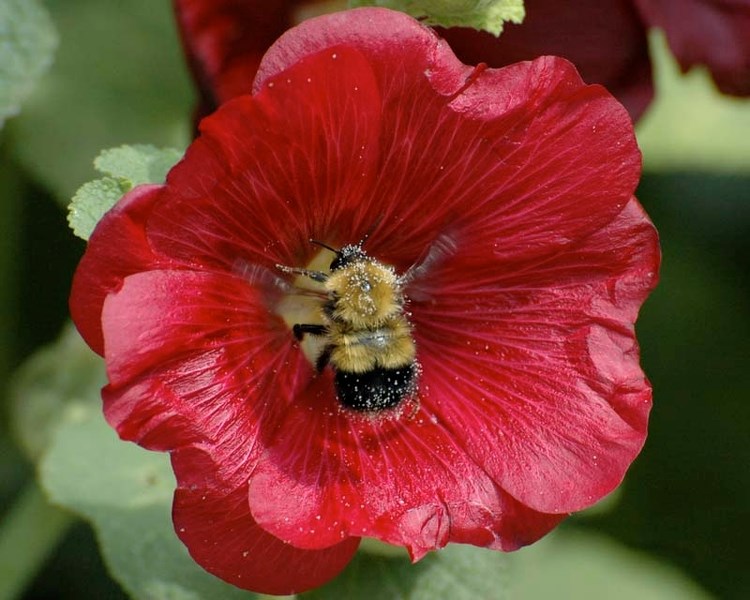I've run into a lot of bumblebees over the years – fat ones, lazy ones, some that buzzed round my ears. But my most memorable encounter was years ago in Calgary by a fence lined with towering hollyhocks, each brimming with huge red, white and violet trumpet-shaped flowers.
I've run into a lot of bumblebees over the years – fat ones, lazy ones, some that buzzed round my ears.
But my most memorable encounter was years ago in Calgary by a fence lined with towering hollyhocks, each brimming with huge red, white and violet trumpet-shaped flowers.
The bumblebees were everywhere, gathering as much pollen as they could – so engrossed in their work that I could get within sniffing distance without them noticing. They'd dive into the blossoms, wings buzzing with excitement, crawl around and re-emerge with big grains of pollen hanging from every hair. Some snuggled right up against the stamens and took a nap – the bee equivalent to hugging a sack of money, I guess.
Bumblebees are some of the fuzziest and most colourful insects we have around Edmonton. Typically striped some combination of yellow, white, orange and black, these chubby figures range in size from a pencil eraser to the size of your thumb and are known for their lazy, ambling flight style.
There are about 15 species of bumblebee in and around St. Albert, most of which look pretty similar, says David Walter, a zoologist at the Royal Alberta Museum.
Some of the most common here are the tricoloured (mostly yellow with a black V between the wings and a broad orange band between two yellow ones on the abdomen), the white-tailed and the red-belted bumblebee.
People often confuse bumblebees with honeybees or wasps, says local beekeeper Malcolm Connell, and he gets about 50 calls a year from residents terrified of such "wasp" nests in their backyards.
Bumblebees are much bigger, yellower and hairier than honeybees, he explains, and far less aggressive than wasps – whereas wasps will sting en masse with little provocation, you have to practically sit on a bumblebee before it will attack.
"They just fly around and pollinate flowers," he says. "They don't bother you and they fly very slow."
Bumblebees live in small, baseball sized wax hives that can show up in the strangest of places: cracks in your wall, holes in the ground and open birdhouses to name a few, Connell says. Colonies start with about two to three bees in April, peak at about 80 in August, and fall to one (the queen) by September.
Gentle giants
Bumblebees spend most of their time gathering nectar and pollen from flowers, says Robin Owen, a biologist at Mount Royal University who has studied them for many years.
"They're really very gentle," he notes, and will even gather pollen off your finger without stinging you. If one flies up to you, it's just checking to see if you're a flower.
Popular myth suggests that bumblebee flight is aerodynamically impossible. That would be true if they flapped their wings up and down, Owen says. However, they flap them forward and backward while rotating them.
"It's more like a helicopter action," he says.
They can, however, gather so much pollen that they're too heavy to fly.
Bees see ultraviolet light, Owen says, which can reveal invisible clues that help them get nectar from a flower.
"A flower that seems white to us will actually have purplish lines on it which direct the bee to the nectar."
Once the bumblebee lands, it will either sip up nectar or gather pollen for the larvae back home. They will use "buzz pollination" in the latter case, buzzing their wings at a specific frequency to vibrate more pollen off the flower onto their bodies.
Bumblebees comb pollen off their bodies and stick it to their back legs for transport – you'll often see big pontoons of the stuff on busy bees.
Back at the hive, they'll scrape off the pollen into pots, sometimes mixing it with nectar in their bellies to regurgitate into the mouths of hungry larvae, Owen says. You might also see them laying on eggs to keep them warm, or fanning their wings by the entrance to blow in cool air.
Bumblebees can be a problem if they set up shop too close to your home, Connell says. Seal cracks in your garage and basement and get rid of old birdhouses to discourage them, he suggests.
Some bumblebee populations are in great decline due to pesticides, parasites and habitat loss, Owen notes. That's a problem, as many native plants rely on them for pollination.
Experts suggest planting a variety of flowers and avoiding pesticides as ways to conserve bumblebees.
Most importantly, Connell says, learn about them and don't panic if you see them.
"I think they're one of nature's marvels."
Bumblebee
Name:
Family name Bombus. Variants include the Cryptic, Nevada, Cuckoo, Confusing, and Perplexing.
Appearance:
Rotund, winged, pollen-gathering insect covered with thick stripes of yellow, orange, white or black hair. Creates loud buzz in flight.
Commonly seen:
Hovering around flowers.
Occasionally confused with:
Wasps, which are thinner and mostly hairless, and honey bees, which are smaller and have less hair.
Fun fact:
They can visit 18 flowers a minute.
Wild St. Albert
Like wildlife? So do we! Every second Wednesday the Gazette profiles a reasonably common wild creature in the St. Albert region. Birds, beasts, bugs, fish … so long as it's alive and kicking, we'll feature it. <br /><br />Got a creature you'd like to see profiled? Send your suggestions to [email protected].




